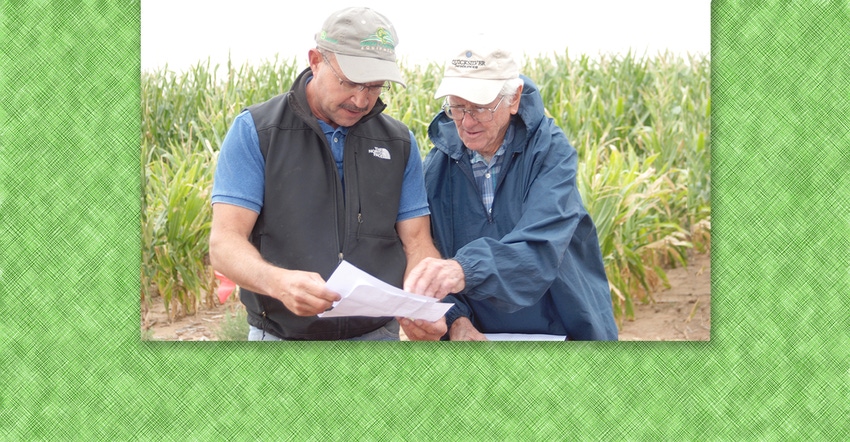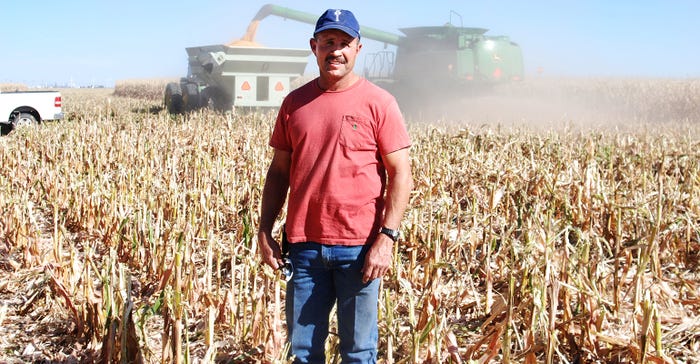September 27, 2017

By Jim Steiert
Leon New, irrigation engineer, district conservationist and demonstration project lead for the North Plains District at Dumas, Texas, is proving that profitable corn yields can come on less water with compelling research findings.
New’s 200-12 project attempting 200-bushel corn on 12 inches of supplemental irrigation, and the current 3-4-5 Gallon Production Maximization Project show that prioritizing net yield per inch is sound business.
“Corn can net more profit per inch of water on less than full irrigation,” New says. His findings are based on the GPM project. Participants apply variable rate irrigation simulating irrigation at 3, 4, and 5 gallons per minute per acre in side-by-side production demonstrations.
What follows is an extensive rundown on the results from the 3-4-5 project, which in the end shows applying water at lower volume can make a big difference. Check out the results for the details.
“The initial year of 3-4-5 in 2015 showed corn averaged 20.06 bushels, or 1,123 pounds per acre-inch of irrigation on 3 GPM; compared to 17.24 bushels, or 965 pounds per acre-inch on 4 GPM; and 15.55 bushels, or 871 pounds per acre-inch in 5 GPM fields," says New.
"Net return per inch was best at 3 GPM at $41.12, while the 4 GPM net return per inch was $34.93, and 5 GPM net return was $31.30. Irrigation totaled 11.16 inches at 3 GPM, 13.64 inches at 4 GPM and 16.02 inches at 5 GPM. Ultimately, 3 GPM had the most net return per inch of water on the crop,” he says.
“Results from 2016 show corn production averaged 15.41 bushels [924 pounds] per acre-inch of irrigation in the 3 GPM fields, compared to 13.80 bushels [828 pounds] in the 4 GPM, and 13.66 bushels [819 pounds] per inch in the 5 GPM fields. Net return from each inch of irrigation averaged $23.47 in the 3 GPM fields, $20.21 in the 4 GPM and $20.15 per inch in the 5 GPM fields,” New adds.
Irrigation in 2016 research averaged 13.53 inches in the 3 GPM fields, compared to15.83 inches in the 4 GPM fields and 17.38 inches in the 5 GPM fields. Corn production averaged 206 bushels [12,394 pounds] per acre in the 3 GPM fields, 212 bushels [12,700 pounds] in the 4 GPM fields, and 227 bushels [13,630 pounds] per acre in the 5 GPM fields. Net return averaged $312.75 per acre from the 3 GPM fields, $306.48 from the 4 GPM fields and $330.62 per acre from the 5 GPM fields. Average net return from the additional 2.30 inches of irrigation applied to the 4 GPM fields than was applied to the 3 GPM fields is $2.72 per inch. Average net return from the additional 3.85 inches of irrigation applied to the 5 GPM fields over the 3 GPM is $4.64 per inch.
One farmer's story
Harold Grall, president of the North Plains Groundwater Conservation District and a longtime cooperator with New’s research, produced over 200 bushels per acre of corn with 2.5 GPM of irrigation available for the season, topping 4- and 5-gallon-per-minute plots by 12 to 18 bushels per acre in 2015.

BANG PER INCH: Harold Grall, president of the North Plains Groundwater Conservation District at Dumas, Texas, is a longtime cooperator with research conducted by Leon New, the district's irrigation engineer, district conservationist and demonstration project lead. He seeks the best net income from corn per inch of water applied.

In 2016 Grall’s irrigation totaled 13.57 inches per acre in his 3 GPM field, 14.85 inches in the 4 GPM field, and 15.82 inches for his 5 GPM field. Net return from each inch of irrigation was $24.79 for the 3 GPM field, compared to $19.44 from the 4 GPM field and $17.56 for the 5 GPM field. Irrigation, rainfall and net soil water totaled 26.37 inches per acre in the 3 GPM field, 25.56 inches in the 4 GPM field, and 24.60 inches in the 5 GPM field. Net return from each inch of irrigation, rainfall and net soil water was $12.75 per acre for the 3 GPM field, $11.29 for the 4 GPM field and $11.29 per acre for his 5 GPM field. Total net return from the 3 GPM field was $336.41 per acre, compared to $288.69 from the 4 GPM field and $277.89 from the 5 GPM field.
Those 2016 results reflected astonishing 200-12 project results amid drought in 2011 and 2012.
“If I had predicted that we’d successfully grow corn on the Texas North Plains on 2.5- and 3-gallons-per-minute-per-acre water, nobody would have believed it,” says New.
“We want the best net income per inch of water applied. We can save water and fertilizer by producing corn that makes a decent yield on less water, and preserve the working life of the aquifer,” Grall says.
The overview of the 2016 3-4-5 GPM Project shows with adequate rainfall, it’s possible to grow corn crops of 200-plus bushels with limited irrigation. The 3-4-5 GPM Project uses comprehensive resource management, including irrigation scheduling and management technologies, maximized delivery systems, conservation tillage practices, hybrid technology, and pest and nutrient management, to optimize conditions for water savings and maximum yield.
“We learned from the 200-12 Project that we were normally overirrigating with 5 gallons per minute, and yields at 3 and 4 were not that much less,” says New. “Irrigators can strategically use less water, improve their efficiency and maintain profitable yields.”
Producers with higher irrigation capacity can reduce the amount of irrigation applied through nozzle package adjustments, or by use of VRI speed control.
Seeding rates ranged from 26,000 to 38,000 seeds per acre, but yields did not increase proportionately without application of a disproportionate volume of irrigation water for the highest seeding rates.
Hybrid selection strategies included using high-yielding, drought-tolerant varieties and focusing on high ear-flex varieties.
Building on irrigation history
The multiyear 3-4-5 GPM Project is building on the success of the North Plains GCD's 200-12 Project, which ended in 2014. Participants in "3-4-5" use variable-rate irrigation to simulate irrigation of 3, 4, and 5 gallons per minute, per acre in side-by-side, production-scale demonstrations. Comprehensive resource management is also incorporated to optimize conditions for water savings and maximum yield.
“We learned from the 200-12 Project that we were normally overirrigating with 5 gallons per minute. Yields at 3 and 4 were not that much less,” says New. “Irrigators can strategically use less water, improve their irrigation efficiency and maintain profitable yields.”
Producers with higher irrigation capacity can reduce the amount of irrigation applied through nozzle package adjustments, or by use of VRI speed control.
Hybrid selection strategies ranged from using high-yielding, drought-tolerant varieties, to focusing on high ear-flex varieties.
Demonstrations initiated in 2015 comparing precision mobile drip irrigation (PMDI) to low-energy precise application (LEPA) irrigation continue. In 2016 PMDI outperformed LEPA by an average of 10 bushels per acre.
New says increasing efficiency from reducing water used to grow corn creates options and opportunities.
“On one hand, by managing production cost through irrigation, seeding rates, hybrids and fertility, in combination with strategic crop residue and soil practices, growers may put more money in the bank, while leaving water in the ground and some profit on the table for later,” says New. “On the other hand, growers with adequate irrigation capacity may operate more efficiently, over more acres, putting more money in the bank now,” New says.
Grant support from the Texas Water Development Board will assist the 3-4-5 GPM Project into 2018.
Steiert writes from Hereford, Texas.
You May Also Like




